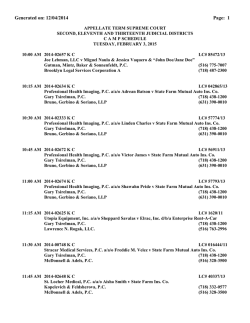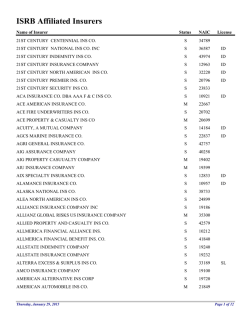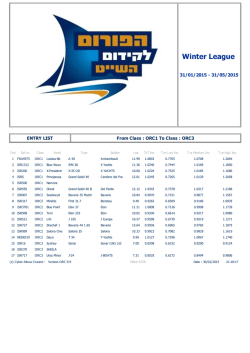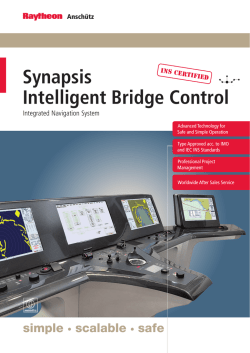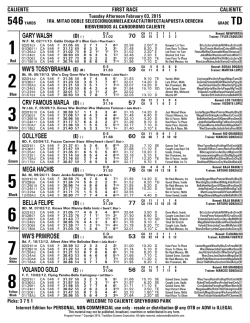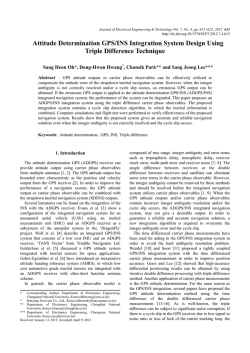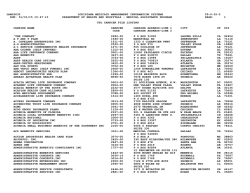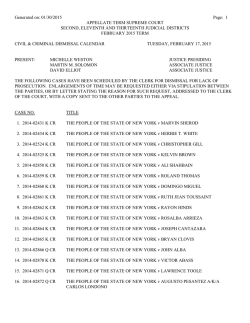
PinDemonium
PinDemonium a DBI-based generic unpacker for Windows executables Sebastiano Mariani - Lorenzo Fontana - Fabio Gritti - Stefano D’Alessio Malware Analysis ● Static analysis : Analyze the malware without executing it ● Dynamic analysis : Analyze the malware while it is executed inside a controlled environment 2 Malware Analysis ● Static analysis : Analyze the malware without executing it ● Dynamic analysis : Analyze the malware while it is executed inside a controlled environment Static Analysis ● ● ● Analysis of disassembled code Analysis of imported functions Analysis of strings 3 Maybe in a fairy tale... What if the malware tries to hinder the analysis process? Packed Malware ● ● Compress or encrypt the original code Code and strings analysis impossible Obfuscate the imported functions Analysis of the imported functions avoided ?? 4 Solutions Manual approach Automatic approach ● Very time consuming ● Fast analysis ● Too many samples to be analyzed every day ● Scale well on the number of samples that has to be analyzed every day ● Adapt the approach to deal with different techniques ● Single approach to deals with multiple techniques 5 All hail PinDemonium 6 Overview PinDemonium is a generic unpacker based on Intel PIN, a dynamic binary instrumentation framework (DBI) 7 What is a DBI? Control Flow Graph Basic Block BB1 Trace BB3 BB2 BB4 BB6 BB7 BB8 BB9 BB10 BB11 BB12 8 What is a DBI? Code Cache BB1 BB3 BB2 Trace is copied in the code cache BB1 BB3 BB2 BB4 BB6 BB7 BB8 BB9 BB10 BB11 BB12 9 What is a DBI? Code Cache BB1 BB3 BB2 BB4 BB6 BB7 DBI provides the possibility to add user defined code after each: - Instruction - Basic Block - Trace BB1 User Defined Code BB3 BB2 BB8 BB9 BB10 BB11 BB12 10 What is a DBI? Code Cache BB1 BB3 BB2 DBI starts executing the program from the code cache BB1 User Defined Code BB4 BB6 BB7 BB3 BB2 BB8 BB9 BB10 BB11 BB12 11 Key idea How can an unpacker be generic? Exploit the functionalities of the DBI to identify the common behaviour of packers: they have to write new code in memory and eventually execute it 12 IAT Recog niz dump e the corre c amon g man t y e the Deobf uscat Dump the m corre emory ctly Detec execu t written a n ted m emor d then y regi ons Our stairway to heaven Packed malware Original malware 13 Our journey begins We begin to build the foundation of our system 14 Detect WxorX memory regions Let’s exploit the key idea behind a generic unpacker implementing the WxorX handler module Concepts: ● ● Write Interval (WI): range of continuously written addresses WxorX law broken: instruction written by the program itself and then executed Idea: Track each program: instruction of the ● Write instruction: get the target address of the write and update the write interval consequently. ● All instructions: check if the EIP is inside a write interval present in the write set. If the condition is met then the WxorX law is broken. 15 Detect WxorX memory regions Steps: Current instr. PinDemonium Write set 0x401000 0x412000 0x413000 0x402000 0x403000 0x401000 0x402000 Legend: EIP value Start addr. End addr. : Instruction with its EIP : Write instruction and its ranges 16 Detect WxorX memory regions Steps: Current instr. PinDemonium 1. The current instruction is a write, no WI present, create the new WI Write set 0x401000 0x412000 0x413000 0x402000 0x403000 0x401000 0x402000 Write interval 1 0x401000 - 0x402000 Legend: EIP value Start addr. End addr. : Instruction with its EIP : Write instruction and its ranges 17 Detect WxorX memory regions Steps: Current instr. PinDemonium Write set 0x401000 0x412000 0x413000 0x402000 0x403000 1. The current instruction is a write, no WI present, create the new WI 2. The current instruction is a write, the ranges of the write overlaps an existing WI, update the matched WI Write interval 1 0x401000 - 0x403000 Legend: EIP value Start addr. End addr. : Instruction with its EIP : Write instruction and its ranges 18 Detect WxorX memory regions Steps: Current instr. PinDemonium 1. The current instruction is a write, no WI present, create the new WI 2. The current instruction is a write, the ranges of the write overlaps an existing WI, update the matched WI 3. The current instruction is a write, the ranges of the write don’t overlap any WI, create a new WI Write set 0x401000 0x412000 0x413000 Write interval 1 0x401000 - 0x403000 Write interval 2 Legend: EIP value Start addr. End addr. 0x412000 - 0x413000 : Instruction with its EIP : Write instruction and its ranges 19 Detect WxorX memory regions Steps: Current instr. PinDemonium 1. The current instruction is a write, no WI present, create the new WI 2. The current instruction is a write, the ranges of the write overlaps an existing WI, update the matched WI 3. The current instruction is a write, the ranges of the write don’t overlap any WI, create a new WI 4. The EIP of the current instruction is inside a WI, WxorX law broken! Write set Write interval 1 0x401000 0x400000 - 0x403000 Write interval 2 Legend: EIP value Start addr. End addr. 0x412000 - 0x413000 : Instruction with its EIP DUMP THE MEMORY! : Write instruction and its ranges 20 Ok the core of the problem has been resolved... … but we have just scratch the surface of the problem. Let’s collect the results obtained so far... 21 Dump the program correctly In order to dump the program we have exploited the capabilities of our dumping module and Scylla PinDemonium Instrumented program memory Steps: 1. 1 The execution of a written address is detected Main Module EIP Written Memory 22 Dump the program correctly In order to dump the program we have exploited the capabilities of our dumping module and Scylla PinDemonium Instrumented progam memory 1 2 Scylla Steps: 1. The execution of a written address is detected 2. PinDemonium calls Scylla Main Module EIP Written Memory 23 Dump the program correctly In order to dump the program we have exploited the capabilities of our dumping module and Scylla PinDemonium Instrumented program memory 2 Scylla Steps: 1 1. The execution of a written address is detected 2. PinDemonium calls Scylla 3. Scylla gets the addresses of the main module 3 Main Module EIP Written Memory 24 Dump the program correctly In order to dump the program we have exploited the capabilities of our dumping module and Scylla PinDemonium Instrumented program memory 2 Scylla Steps: 1 3 The execution of a written address is detected 2. PinDemonium calls Scylla 3. Scylla gets the addresses of the main module 4. Scylla dumps the main module along with the written addresses on a file 4 Main Module EIP 1. Written Memory Main Module Written Memory 25 Have we already finished? Nope... 26 Unpacking on the heap What if the original code is written on the heap? PinDemonium Instrumented program memory Steps: Main Module Heap EIP Written Memory 27 Unpacking on the heap What if the original code is written on the heap? PinDemonium Instrumented program memory 2 Scylla Steps: 1 3 Heap Written Memory The execution of a written address is detected 2. PinDemonium calls Scylla 3. Scylla gets the addresses of the main module 4. Scylla dumps the main module 4 Main Module EIP 1. Main Module WRONG! 28 Unpacking on the heap The OEP doesn’t make sense! 29 Unpacking on the heap Solution Add the heap memory range in which the WxorX rule has been broken as a new section inside the dumped PE! 1. Keep track of writeintervals located on the heap 2. Dump the heap-zone where the WxorX rule is broken 3. Add it as a new section inside the PE 4. Set the OEP inside this new added section 30 Unpacking on the heap The OEP is correct! 31 Unpacking on the heap However, the dumped heap-zone can contain references to addresses inside other not dumped memory areas! 32 Unpacking on the heap 1. Retrieve all the currently allocated heap-zones Solution Dump all the heap-zones and load them in IDA in order to allow static analysis! 2. Identify the new allocated or modified ones by comparing the MD5 of their previous content 3. Dump these heap-zones 4. Create new segments inside the .idb for each of them 5. Copy the heap-zones content inside these new segments! 33 Unpacking on the heap 34 Two down, two still standing! Reverser we are coming for you! Let’s deobfuscate some imported functions... 35 Deobfuscate the IAT Extended Scylla functionalities: ● IAT Search : Used Advanced and Basic IAT search functionalities provided by Scylla ● IAT Deobfuscation : Extended the plugin system of Scylla for IAT deobfuscation 36 Deobfuscate the IAT Steps: 1. Is the address 0x04000012 inside the DLL memory region? No, continue until next jump… ins_delta = 0 2. Is the address 0x04001000 inside the DLL memory region? No, continue until next jump… ins_delta = 8 3. Is the address 0x75000010 inside the DLL memory region? YES! Let’s patch the IAT entry ins_delta = 16 0x04000000 0x04000012 ADD EAX, 4 1 0x04000012 ADD EAX, 4 MOV EBP, [ESP] MOV EBP, [ESP] POP EBP JMP 0x04001000 PUSH EAX 2 3 0x04001000 SUB ECX, 1 POP EBP MessageBox + 0x14 PUSH EAX MessageBox + 0x18 0x75000000 Messagebox Entry point [0x4000012] = (0x75000010 - 16) = 0x75000000 CORRECT! JMP 0x75000010 37 One last step... Too many dumps, too many programs making too many problems… Can’t you see? This is the land of confusion 38 Recognize the correct dump We have to find a way to identify the correct dump Idea 1. Entropy difference Give for each dump a “quality” index using the heuristics defined in our heuristics module 39 Recognize the correct dump We have to find a way to identify the correct dump Idea 1. Entropy difference Give for each dump a “quality” index using the heuristics defined in our heuristics module 2. Far jump 40 Recognize the correct dump We have to find a way to identify the correct dump Idea 1. Entropy difference Give for each dump a “quality” index using the heuristics defined in our heuristics module 2. Far jump 3. Jump outer section 41 Recognize the correct dump We have to find a way to identify the correct dump Idea 1. Entropy difference Give for each dump a “quality” index using the heuristics defined in our heuristics module 2. Far jump 3. Jump outer section 4. Yara rules 42 Yara Rules Yara is executed on the dumped memory and a set of rules is checked for two main reasons: Detecting Evasive code Identifying malware family Detect patterns of evasive code which may have prevented the complete unpacking of the malware like Anti-VM and Anti-Debug techniques When a known malware family rule is matched after multiple unpacking layers probably this is the correct dump 43 Advanced Problems You either die a hero or you live long enough to see yourself become the villain Exploit PIN functionality to break PIN A.k.a. Self modifying code 45 Self modifying code Steps: Code Cache ins_1 ins_2 wrong_ins_3 ins_4 ins_5 Main module of target program 46 Self modifying code Steps: ins_1 ins_2 crash_ins_3 ins_4 1. The trace is collected in the code cache Collected trace ins_1 ins_2 crash_ins_3 ins_4 ins_5 47 Self modifying code Steps: Execution starts ins_1 ins_2 crash_ins_3 ins_4 1. The trace is collected in the code cache 2. The execution starts in the code cache ins_1 ins_2 crash_ins_3 ins_4 ins_5 48 Self modifying code Steps: Execution starts ins_1 ins_2 crash_ins_3 ins_4 Patch ins_1 ins_2 ins_3 ins_4 ins_5 1. The trace is collected in the code cache 2. The execution starts in the code cache 3. The wrong instruction is patched in the main module 49 Self modifying code Steps: Execute here ins_1 ins_2 crash_ins_3 ins_4 ins_1 ins_2 ins_3 ins_4 ins_5 1. The trace is collected in the code cache 2. The execution starts in the code cache 3. The wrong instruction is patched in the main module 4. The wrong_ins_3 is executed CRASH! 50 Solution Self modifying code Steps: ins_1(write) ins_2 crash_ins_3 ins_4 List of written addresses ins_1 ins_2 crash_ins_3 ins_4 ins_5 52 Self modifying code Steps: 1. 1 CheckEipWritten() MarkWrittenAddress() ins_1 ( write ) CheckEipWritten() ins_2 CheckEipWritten() crash_ins_3 CheckEipWritten() ins_4 Insert one analysis routine before each instruction and another one if the instruction is a write List of written addresses ins_1 ins_2 crash_ins_3 ins_4 ins_5 53 Self modifying code Steps: IP CheckEipWritten() MarkWrittenAddress() ins_1 ( write ) CheckEipWritten() ins_2 CheckEipWritten() crash_ins_3 CheckEipWritten() ins_4 1. Insert one analysis routine before each instruction and another one if the instruction is a write 2. Execute the analysis routine before the write List of written addresses 2 crash_ins_3_addr ins_1 ins_2 crash_ins_3 ins_4 ins_5 54 Self modifying code Steps: IP CheckEipWritten() MarkWrittenAddress() ins_1 ( write ) CheckEipWritten() ins_2 CheckEipWritten() crash_ins_3 CheckEipWritten() ins_4 List of written addresses 3 1. Insert one analysis routine before each instruction and another one if the instruction is a write 2. Execute the analysis routine before the write 3. The crash_ins_3 is patched in the main module crash_ins_3_addr ins_1 ins_2 ins_3 ins_4 ins_5 55 Self modifying code Steps: IP CheckEipWritten() MarkWrittenAddress() ins_1 ( write ) CheckEipWritten() ins_2 CheckEipWritten() crash_ins_3 CheckEipWritten() ins_4 List of written addresses crash_ins_3_addr 4 1. Insert one analysis routine before each instruction and another one if the instruction is a write 2. Execute the analysis routine before the write 3. The crash_ins_3 is patched in the main module 4. Check if ins_2 address is inside the list NOPE… ins_1 ins_2 ins_3 ins_4 ins_5 56 Self modifying code Steps: IP CheckEipWritten() MarkWrittenAddress() ins_1 ( write ) CheckEipWritten() ins_2 CheckEipWritten() crash_ins_3 CheckEipWritten() ins_4 List of written addresses crash_ins_3_addr 1. Insert one analysis routine before each instruction and another one if the instruction is a write 2. Execute the analysis routine before the write 3. The crash_ins_3 is patched in the main module 4. Check if ins_2 address is inside the list 5 ins_1 ins_2 ins_3 ins_4 ins_5 NOPE… 5. Check if crash_ins_3 address is inside the list YES! 57 Self modifying code Steps: CheckEipWritten() MarkWrittenAddress() ins_1 ( write ) CheckEipWritten() ins_2 CheckEipWritten() crash_ins_3 CheckEipWritten() ins_4 List of written addresses 1. Insert one analysis routine before each instruction and another one if the instruction is a write 2. Execute the analysis routine before the write 3. The crash_ins_3 is patched in the main module 4. Check if ins_2 address is inside the list 6 crash_ins_3_addr NOPE… ins_1 ins_2 ins_3 ins_4 ins_5 5. Check if crash_ins_3 address is inside the list YES! 6. Stop the execution 58 Self modifying code Steps: 7 CheckEipWritten() MarkWrittenAddress() ins_1 ( write ) CheckEipWritten() ins_2 CheckEipWritten() ins_3 CheckEipWritten() ins_4 List of written addresses crash_ins_3_addr 1. Insert one analysis routine before each instruction and another one if the instruction is a write 2. Execute the analysis routine before the write 3. The crash_ins_3 is patched in the main module 4. Check if ins_2 address is inside the list NOPE… ins_1 ins_2 ins_3 ins_4 ins_5 5. Check if crash_ins_3 address is inside the list YES! 6. Stop the execution 7. Recollect the new trace CORRECT! 59 Are there other ways to break the WxorX rule? Process Injection 60 Process Injection Inject code into the memory space of a different process and then execute it ● Dll injection ● Process hollowing ● Reflective Dll injection ● Entry point patching OUR WxorX TRACKER IS NO MORE SUFFICIENT! 61 Solution Process Injection Identify remote writes to other processes by hooking system calls: ● NtWriteVirutalMemory ● NtMapViewOfSection Identify remote execution of written memory by hooking system calls: ● NtCreateThreadEx ● NtResumeThread ● NtQueueApcThread 63 Finally for the SWAG! Experiments ➔ Test 1 : test our tool against the same binary packed with different known packers. ➔ Test 2 : test our tool against a series of packed malware sample collected from VirusTotal. 65 Experiment 1 : known packers Upx FSG Xcom p PEloc k Mew mpress PeCompa ct Obsidium ExePacker ezip MessageBox. exe WinRAR.exe ASProte ct ASPack eXpress or exe32pac ker beropac Hyperio ker n PeSpin MessageBox. exe WinRAR.exe Original code dumped but Import directory not reconstructed 66 Experiment 2 : wild samples Number of packed (checked manually) samples 1066 N° % Unpacked and working 519 49 Unpacked but Different behaviour 150 14 Unpacked but not working 139 13 Not unpacked 258 24 67 Experiment 2 : wild samples Number of packed (checked manually) samples 1066 Unpacked and working N° % of all 519 49 63% Unpacked but Different behaviour 150 14 Unpacked but not working 139 13 Not unpacked 258 24 68 DEMO More advanced IAT obfuscation techniques are not handled Limitations Packers which reencrypt / compress code after its execution are not supported Evasion techniques are not handled 70 Generic unpacker based on a DBI Able to reconstruct a working version of the original binary Conclusions Able to deal with IAT obfuscation and dumping on the heap 17 common packers defeated 63% of random samples correctly unpacked (known and custom packers employed) 71 The source code is available at https://github.com/Seba0691/PINdemonium Thank you!
© Copyright 2024
